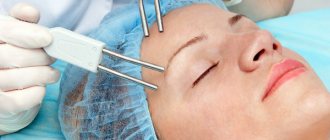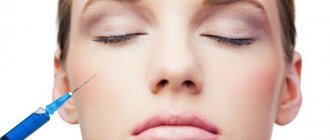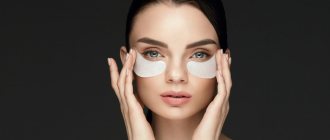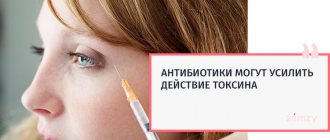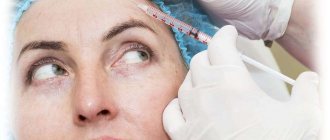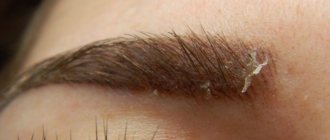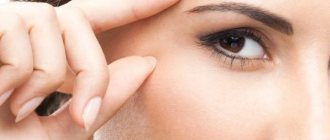According to statistics, ptosis (drooping) of the upper eyelid occurs in 16-18% of patients in cosmetic clinics after botulinum therapy. Moreover, even visitors to very expensive offices and highly qualified doctors are not immune from such a side effect, since in many cases it develops for reasons beyond the cosmetologist’s control.
Moreover, as a cosmetic defect, ptosis is very critical for the patient. Simply put, it catches the eye and spoils the appearance of the face more than the wrinkles themselves, which they try to get rid of with Botox injections and similar drugs. If after such procedures the patient’s eyelids droop, this not only disrupts natural facial expressions, but generally looks like a pathology, giving the face an unpleasant tired expression and the gaze a heaviness. In the most serious cases, blepharoptosis can even create physical discomfort for the patient if the sagging is too severe and the eyelid literally closes the eye.
For example, in the photo below there is a relatively mild ptosis that does not interfere with the patient, but affects his appearance:
And here is a rather severe form:
But perhaps even more unpleasant is that ptosis after botulinum therapy is difficult to correct. Next we will see that there are ways to correct it, but they are very limited and do not provide quick results.
This means that even before Botox injections, you need to figure out why such a problem may arise after the procedure, how to reduce the likelihood of a side effect, and what to do if the eyelids, and even more so the eyebrows, are already drooping and sagging.
What is drooping eyelids after Botox (ptosis)
Drooping of the eyelid (ptosis) develops when the muscles that support the shape of the eye are disrupted. The upper eyelid droops, impairing eye opening, and drooping lower eyelid leads to dry eye. It looks ugly and causes discomfort.
What does ptosis look like, photo
The most common form of ptosis is drooping of the outer edge of the upper eyelid. The shape of the eye changes, the eyelid blocks part of the view, which leads to vision impairment. At best, the consequences of such ptosis are deterioration of appearance and inconvenience, but at worst, distortion of vision is possible - double vision, lacrimation, blurred vision.
Other forms are also possible - drooping of the lower eyelid, in which the mucous membrane of the eyelid is exposed, lacrimation, dry eyes occur, and vision deteriorates.
How to prolong the effect of treatment?
If the patient carefully follows all the recommendations and prescriptions of the cosmetologist regarding the treatment of drooping upper eyelids, then eventually this complication gradually disappears. To consolidate the result, it is advisable to listen to simple advice. One of them concerns the need to continue to massage to keep the muscles toned. Doctors recommend starting to do gymnastics specifically designed for the face - face building. It helps train muscle fibers. It is necessary to apply a firming eye cream every morning and evening. A mask using gelatin can help a lot. You should mix 1 tbsp. l. gelatin and milk. After it dissolves, add a capsule of vitamin A and E and apply the mixture to your eyelids. Once it dries, wash using warm water.
Mechanism of occurrence
The active ingredient in Botox is a toxin that causes muscle paralysis. When administered correctly, it has an effect in those areas where wrinkles appear - it relaxes facial muscles, smoothes the skin, and helps make the face look younger.
If Botox is administered incorrectly, its effect affects places where it was not intended. Eyelid ptosis is caused by Botox injected into the corners of the eyes to correct crow's feet. The Botox injection procedure requires a very precise calculation of the injection point, so doctor errors are possible.
Who is to blame for the complication?
It is difficult to answer this question unequivocally. Exactly where Botox works depends on several factors:
- Correct calculation of the drug administration point;
- Accuracy of the procedure;
- Distribution of the substance under the skin after the procedure.
The first two factors are influenced by the skill of the doctor - only a good specialist can correctly calculate the area of injection of the medicine and place the injection exactly at the right point. On the other hand, after the procedure, the medicine is distributed under the skin for some time (this can take up to a day).
During this time, the patient must observe a number of restrictions - you cannot touch your face, fall asleep face down, you need to control your facial expressions, protect your skin from sudden temperature changes, and do not wear makeup. If this is not done, the drug will not end up where the doctor administered it.
The most common mistake patients make is coming to an eyelid Botox procedure without sunglasses. Prolonged squinting from bright light can negate all the doctor’s efforts.
A little about Botox
Do you know how quickly our skin loses its elasticity? At 70 years old, this ratio is only 30% compared to her condition at a young age. On dry skin, wrinkles appear faster and are more noticeable to others. Botox, or more precisely, botulinum toxin, restores its elasticity by 30%. The maximum effect is achieved two months after the course.
The anatomical feature of facial wrinkles is their fixation and location. They arise under the influence of muscle contractions when a person expresses emotions. The botulinum drug not only removes them, but also has a preventive effect. There is a gradual smoothing of wrinkles and visible rejuvenation of the face. Botox keeps the skin elastic throughout the duration of activity. The principle of its operation is not camouflage. Due to muscle paralysis, their excessive mobility is limited, which prevents the appearance of new folds.
Proven! After injections of the drug, the skin is partially modeled. Botox even affects the deep layers of the skin.
Before carrying out a cosmetic procedure to eliminate wrinkles in the eye area, it is necessary to take into account the risks of side effects.
Reasons for the development of ptosis
Ptosis can develop not only due to incorrect actions of the doctor or patient, but also for physiological reasons. Anyone who does Botox around the eyes for the first time is exposed to these risks:
- Low muscle tone of the eyelid - in this case, Botox reduces it even more, and the result is obvious in the most literal sense of the word;
- An allergic reaction with severe swelling - not a single person is immune from it either. Edema severely deforms facial tissues, leading to its asymmetry, causing pain and severe discomfort;
- Disorders of microcirculation of blood and lymph in the tissues of the eye - Botox aggravates them, which also causes swelling.
Not a single patient is immune from such situations, especially if she decided to undergo Botox for the first time. If such complications arise, you need to contact a cosmetologist.
Diagnostics
Ophthalmology diagnoses ptosis by conducting the following studies:
- measuring the height of the upper eyelid;
- at the moment of blinking, they study whether the skin folds are symmetrical or not;
- measure muscle tone;
- the neuropathologist makes his conclusion;
- electromyography of the muscle is performed;
- Brain MRI;
- Ultrasound of the eyes;
- X-ray of the orbit, autorefractometry;
- perimetry;
- measure the angle of biological strabismus;
- study convergence;
- Binocular vision is checked.
Of course, an ophthalmologist will not do all of the above tests. He performs an external examination, prescribes tests and directs some diagnostic tests that will help make the most accurate diagnosis and choose the right treatment.
Degrees of ptosis
Ptosis varies in the degree of impact on the patient’s life:
- First degree (partial ptosis) – the eyelid is drooping, but the volume of the palpebral fissure is reduced by no more than 1/3;
- Incomplete (2nd degree) – a drooping eyelid covers 2/3 of the iris, accompanied by significant visual impairment (double vision, lacrimation, narrowed vision);
- Complete (3rd degree) – the palpebral fissure is completely blocked, the drooping eyelid makes it impossible to see with the affected eye.
With Botox, partial ptosis most often develops, and incomplete ptosis is extremely rare. Complete ptosis develops in severe forms of allergy to the drug.
What to do if this happens
Treatment options for ptosis depend on what exactly caused the ptosis. You should start the fight against facial asymmetry with a consultation with a cosmetologist - the doctor can determine which method of fight is best suited.
You should prepare for the fact that the treatment will be long, and you will have to put up with unsightly changes for some time.
Can it go away on its own?
Mild ptosis goes away on its own in 2-3 weeks. This is possible if ptosis is caused by improper distribution of the drug.
Controlling facial expressions, wearing sunglasses, washing with tonic solutions and sleeping on your back or the opposite side will help speed up this process so that blood does not flow to the damaged eyelid.
Ptosis correction
If additional manipulations are required, the choice of each of them depends on individual characteristics:
- Injecting an additional dose of Botox to relieve the tone of the antagonist muscles. The tone of all muscles acting on the eyelid is leveled, the eyelid returns to its normal position;
- Taking medications that correct muscle tone (raise the edge of the eyelid by 1-2mm, allow you to cope with mild ptosis, improve the appearance with moderate ptosis, but are ineffective with complete ptosis);
- Eye drops with vitamin complexes and mesotherapy cocktails enhance the effectiveness of other medications and accelerate recovery processes in the eye;
- Microcurrents and myostimulation restore muscle tone;
- Massage, including self-massage.
The doctor prescribes these procedures primarily to speed up the restoration of eyelid muscle tone.
Camouflage methods
During the period when ptosis still persists, camouflage should be considered. You can do this with makeup that distracts attention from the shape of the eyelid and visually equalizes the size of the eyes.
If you cannot cope with ptosis, you can resort to a radical measure - injecting Botox into the other eye so that the second eyelid droops symmetrically. At the same time, the face takes on a tired and sleepy expression, but after 6-7 months the Botox effect will end and the appearance will return to its normal state.
Surgery
Surgical treatment is used only if the patient suffers from a severe form of ptosis, which practically does not occur after Botox.
There is no need for surgery; injections and masking methods do the job.
Auxiliary procedures
To increase the effectiveness of treatment, thermal procedures are used - heating improves the ability of the drug to be distributed throughout the muscle tissue, and this allows the toxin to be shifted to where it should be.
It is also useful to combine warming with massage - the eyelids are massaged with careful movements from the inner edge to the outer and temples. Another massage option is gentle finger pressure - they increase blood flow in the eyelids, stimulate muscle activity, and restore their tone.
To improve the condition of the eyelids, it is recommended to massage several times a day, and warm up every day. The earlier the treatment complex is started, the greater its effectiveness.
Symptoms
You may be interested in: Aloe vera cream: composition and beneficial properties
In order not to confuse ptosis after injections with other pathologies, you need to know about the symptoms. The eyelid may droop either on the third day or after a few weeks. This is very noticeable. Obvious asymmetry gives the face an unpleasant, tired expression and the gaze a heaviness. In this case, blinking is impaired, as a result the eyeball is almost deprived of hydration and cleansing, as well as:
- your eyes begin to hurt;
- blood circulation is impaired;
- headaches, strabismus and lacrimation appear.
By location, swelling is most often unilateral, but it can also be bilateral. Thus, a situation may arise when, for one reason or another, the eyelids droop after Botox. What to do? Photos and reviews of other patients, the opinions of doctors - all this is of interest, but the main thing is not to panic.
How to prevent drooping eyelids after the procedure
In order for the procedure to bring the desired effect and not spoil the appearance, it is important to pay attention to many subtleties and nuances. To begin with, you should remember that applying Botox around the eyes (for crow's feet) and on the forehead (less often) carries the risk of drooping eyelids or eyebrows, and you need to be prepared for this. There is always a risk that something will go wrong, but it can be reduced.
To begin with, you need to carefully consider the choice of clinic and specialist. For those who have decided to undergo the procedure for the first time, it is useful to read reviews or ask the opinions of those who have already done the procedure. Those who are doing Botox not for the first time already have experience communicating with doctors, and should contact their trusted cosmetologist.
A good cosmetologist understands that the facial structure has many individual characteristics, and there is no universal scheme that gives the right result for all patients. The drug is administered at strictly defined points, which are calculated anew each time for each patient. Correct administration of the drug and accurate dosage calculations can reduce the risk of undesirable consequences.
The procedure itself takes a little time, but after it the recovery period lasts about a day. During this time, botulinum toxin can move from the place where it was injected to neighboring areas. To avoid this, you must observe a number of restrictions:
- For the first 2-3 hours after surgery, you need to monitor your facial expressions. It is especially dangerous to squint around the eyes after Botox. You need to take sunglasses with you to the procedure, even if the weather outside is cloudy. Those who have vision problems should wear glasses and avoid contact lenses for a while;
- At the same time, you should not touch your face, especially the area where the procedure was performed;
- You should not do any activities that require working in an inclined position (washing the floor, etc.);
- It is better to sleep 4-5 hours after Botox, in a supine position. There is no need to lower your face;
- It is advisable to refrain from using cosmetics for 24 hours after the procedure; you can use care products in neighboring areas, but without touching the area where the injections were performed.
When performing the procedure, the doctor will explain all these subtleties and give recommendations on how to ensure that the drug remains in the same place where it was injected. After Botox, you will feel discomfort for some time, what is especially unpleasant is that the skin will itch, and it is undesirable to scratch it.
There may be slight redness and swelling at the injection sites, which will subside within a few hours or a day at most. If pain occurs, and external changes do not go away, but progress, you need to consult a doctor - this is a sign of dangerous processes occurring in the skin.
Types of threads for lifting
There are many types of threads for eyebrow lifting. But the best ones are considered to be Aptos, Mesothreads and gold ones. Each type has its positive and negative sides. Therefore, it is best to entrust the choice of material to a beauty specialist, who must take into account the client’s preferences.
The main differences between Aptos, Golden and Mesothread threads:
- Aptos began to be used not so long ago. Aptos are made from unique suture materials and have a serrated shape, allowing them to penetrate deep into the skin. Unlike other types, they do not dissolve and when inserted they connect with internal tissues. Thus, not only the top layer, but also the subcutaneous layer is leveled. Since they do not dissolve, they are overgrown with a layer of new cells, forming a dense framework. Because of this, the skin will be smooth for a long time, up to 3 years. Aptos threads have only one drawback: a repeated procedure can cause difficulties, since there will already be a dense framework under the skin.
- Gold threads have another name - platinum. Eyebrow lifting with gold threads was popular in the second half of the 20th century, and currently they have not lost their popularity. Since gold does not oxidize and has a rejuvenating effect. In order for the fishing line to pass freely under the skin, it is coated with polyglycolic acid. Brow lifting with gold threads guarantees a long-lasting effect that lasts from 5 to 10 years. The disadvantage of these threads is that after using them, any procedures using a laser are prohibited.
- And another most common material is mesothreads. Most often, they are recommended for women undergoing a brow lift for the first time or for young girls. Since they are very flexible and delicate, unlike other types, they are easily fixed and completely disappear over time. They give the same effect as Aptos threads; they also smooth the skin in the eye area, forehead, and lift the eyebrows and eyelids. After their introduction, a temporary frame is formed, which is overgrown with cells, after which the material disappears. Thus, the material is completely absorbed, leaving no trace 3 years after the operation, so any other operations and interventions are not prohibited. However, these threads are not suitable for women over 50 years old, as they only level the top layer and will not bring the desired result.
About lifting the upper eyelids with threads >>
These types of threads are the most common and effective. A lot when choosing threads depends on the age and skin type. But you should always give preference to quality materials. Therefore, it is best to contact only experienced specialists. Using low-quality material and lack of experience can lead to dire consequences.
Tips and tricks on the topic
Before you decide to undergo facial Botox, you need to pay attention to the features of your facial expressions. There are situations when toxin injections will not rejuvenate the face, but will lead to completely unnecessary consequences. The first thing you need to pay attention to is how much your face changes throughout the day.
If, due to fatigue, nervous tension or lack of sleep, the face takes on a tired expression with slightly drooping eyelids, a slight asymmetry of the face appears, and this sharply contrasts with the appearance of the face after rest, then Botox is undesirable - the facial muscles are already prone to decreased tone, and botulinum toxin can “fix” a tired expression. If this phenomenon began to appear only recently, then it can be corrected - soothing procedures, facial massage, and skin care will help.
Minor neurological symptoms on the face - nervous twitching of the eyelid, slight asymmetry of the face that occurs during stress or is constantly present - are reasons to undergo an examination by a neurologist, and only then think about decorating your face. In such conditions, Botox can give a completely unpredictable effect, which will take a long time to get rid of.
If the patient has already experienced drooping eyelids, but decides to undergo Botox, you need to warn the doctor about this. You should also talk about what led to the ptosis last time, what actions were taken, and how effective they were.
For Botox, as for any procedure, there are contraindications, and before you take care of your appearance, the first thing you need to do is undergo an examination and make sure that certain procedures are safe to carry out. In some cases, it makes no sense to carry out expensive cosmetic procedures - perhaps you should abandon them.
Conclusions -
Thus, the first thing you should do is understand which specialist you came to see and whether he has the right to perform botulinum toxin injections.
Secondly, you should be wary if the cosmetologist immediately suggested that you do botulinum toxin injections on this first visit, and not on the “Botox day”. This means that the drug has either already been diluted in advance, or the remainder of the drug will go to other gullible suckers. If the doctor took out a syringe that had already been drawn up in advance, and you did not see him drawing it from the bottle, this means that you have a re-frozen and thawed drug in front of you. Some patients, when you start telling them this, begin to very zealously defend such a specialist. It’s like nothing that the drug was diluted in advance, because Botox “got up” after that. But besides the fact that he “got up” or “didn’t get up”, there are other criteria, for example, the duration of action of the drug (24stoma.ru). In addition, this can have an impact on the development of resistance to botulinum toxins - lead to the production of so-called blocking antibodies by the immune system (and then gradually the botulinum toxins will no longer affect you at all). And lastly, this is the deliberate provision of obviously low-quality services.
As for comparing the effectiveness of different botulinum toxin preparations, as we showed above, there are many simultaneously influencing factors that patients are not even aware of. And these are not only different names of drugs and the number of units, but also the degree of dilution of the drug, the “freshness” of the solution, the correct injection technique, and, banally, the honesty of the cosmetologist.
How Botox should work: Before and After video
Experts' opinion
The advantage of Botox is that the procedure itself takes 10-15 minutes and does not affect the ability to work, which is why in Europe it is called the lunch break procedure. However, experts advise spending more time on the preliminary examination and subsequent recovery period to reduce the risk of undesirable consequences. Even if Botox is not done for the first time, such subtleties should not be neglected.
If ptosis occurs, you don’t have to do anything if it only causes aesthetic discomfort - muscle activity recovers on its own within six months. During this time, the patient will have to endure a number of inconveniences - spoiled appearance, facial asymmetry, unwanted attention from others, but over time this will end. Those for whom it is very important to maintain a beautiful appearance need to think about treating or camouflaging ptosis.
According to statistics, ptosis occurs in 16-18% of cases, so before the procedure you should weigh your preferences and possible risks - are the problems with your face so severe that they are worth solving at the cost of the risk of getting even bigger problems. Even with repeated Botox, the risk does not decrease, so experienced patients face the same dangers as those who decided to make such changes for the first time.
Watch the video on the topic:
